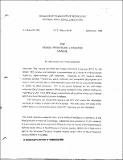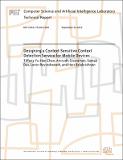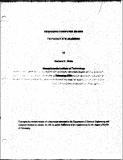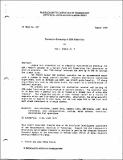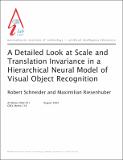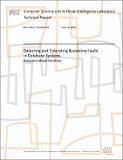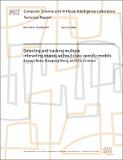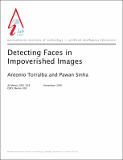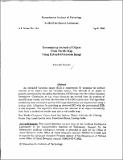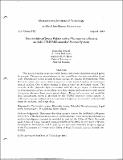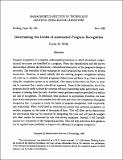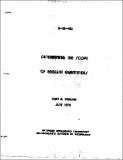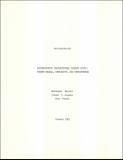Browsing Computer Science and Artificial Intelligence Lab (CSAIL) by Title
Now showing items 901-920 of 3804
-
The Design Procedure Language Manual
(1980-09-01)This manual describes the Design Procedure Language (DPL) for LSI design. DPL creates and maintains a representation of a design in a hierarchically organized, object-oriented LISP data-base. Designing in DPL involves ... -
Design Strategies for File Systems
(1970-10)This thesis describes a methodology for the analysis and synthesis of modern general purpose file systems. The two basic concepts developed are (1) establishment of a uniform representation of a file's structure in the ... -
Designing a Context-Sensitive Context Detection Service for Mobile Devices
(2015-09-24)This paper describes the design, implementation, and evaluation of Amoeba, a context-sensitive context detection service for mobile devices. Amoeba exports an API that allows a client to express interest in one or more ... -
Designing Computer Games to Facilitate Learning
(1981-02-01)The aim of this thesis was to explore the design of interactive computer learning environments. The particular learning domain selected was Newtonian dynamics. Newtonian dynamics was chosen because it is an important ... -
Destriping Satellite Images
(1978-03-01)Before satellite images obtained with multiple image sensors can be used in image analysis, corrections must be introduced for the differences in transfer functions on these sensors. Methods are here presented for ... -
Destructive Reordering of CDR-Coded Lists
(1980-08-01)Linked list structures can be compactly represented by encoding the CDR ("next") pointer in a two-bit field and linearizing list structures as much as possible. This "CDR-coding" technique can save up to 50% on storage ... -
A Detailed Look at Scale and Translation Invariance in a Hierarchical Neural Model of Visual Object Recognition
(2002-08-01)The HMAX model has recently been proposed by Riesenhuber & Poggio as a hierarchical model of position- and size-invariant object recognition in visual cortex. It has also turned out to model successfully a number of ... -
Detecting and Tolerating Byzantine Faults in Database Systems
(2008-06-30)This thesis describes the design, implementation, and evaluation of a replication scheme to handle Byzantine faults in transaction processing database systems. The scheme compares answers from queries and updates on multiple ... -
Detecting and tracking multiple interacting objects without class-specific models
(2006-04-25)We propose a framework for detecting and tracking multiple interacting objects from a single, static, uncalibrated camera. The number of objects is variable and unknown, and object-class-specific models are not available. ... -
Detecting Digital Forgeries Using Bispectral Analysis
(1999-12-01)With the rapid increase in low-cost and sophisticated digital technology the need for techniques to authenticate digital material will become more urgent. In this paper we address the problem of authenticating digital ... -
Detecting Faces in Impoverished Images
(2001-11-05)The ability to detect faces in images is of critical ecological significance. It is a pre-requisite for other important face perception tasks such as person identification, gender classification and affect analysis. Here ... -
Detecting Hazardous Intensive Care Patient Episodes Using Real-time Mortality Models
(2009-08-26)The modern intensive care unit (ICU) has become a complex, expensive, data-intensive environment. Caregivers maintain an overall assessment of their patients based on important observations and trends. If an advanced ... -
Determining articulator configuration in voiced stop consonants by matching time-domain patterns in pitch periods
(2005-01-28)In this thesis I will be concerned with linking the observed speechsignal to the configuration of articulators.Due to the potentially rapid motion of the articulators, the speechsignal can be highly non-stationary. The ... -
Determining Attitude of Object from Needle Map Using Extended Gaussian Image
(1983-04-01)An extended Gaussian image (EGI) is constructed by mapping the surface normals of an object onto the Gussian sphere. The attitude of an object is greatly constrained by the global distribution of EGI mass over the ... -
Determining Grasp Points Using Photometric Stereo and the PRISM Binocular Stereo System
(1984-08-01)This paper describes a system which locates and grasps doughnut shaped parts from a pile. The system uses photometric stereo and binocular stereo as vision input tools. Photometric stereo is used to make surface ... -
Determining Optical Flow
(1980-04-01)Optical flow cannot be computed locally, since only one independent measurement is available from the image sequence at a point, while the flow velocity has two components. A second constraint is needed. A method for ... -
Determining Shape and Reflectance Using Multiple Images
(1978-08-01)Distributions of surface orientation and reflectance factor on the surface of an object can be determined from scene radiances observed by a fixed sensor under varying lighting conditions. Such techniques have potential ... -
Determining the Limits of Automated Program Recognition
(MIT Artificial Intelligence Laboratory, 1989-06)Program recognition is a program understanding technique in which stereotypic computational structures are identified in a program. From this identification and the known relationships between the structures, a hierarchical ... -
Determining the Scope of English Quantifiers
(1978-06-01)How can one represent the meaning of English sentences in a formal logical notation such that the translation of English into this logical form is simple and general? This report answers this question for a particular ... -
Deterministic Propositional Dynamic Logic: Finite Models, Complexity, and Completeness
(1981-01)Let p be a formular in deterministic propositional dynamic logic. A decision procedure for the satisfiability of p is given along with a construction of a finite model for every satisifiable p. The decision procedure runs ...

